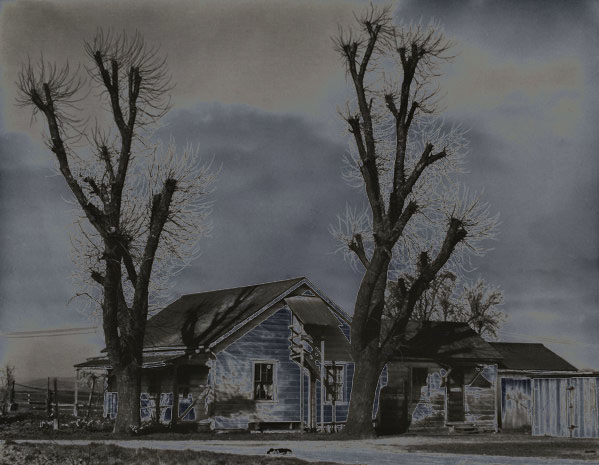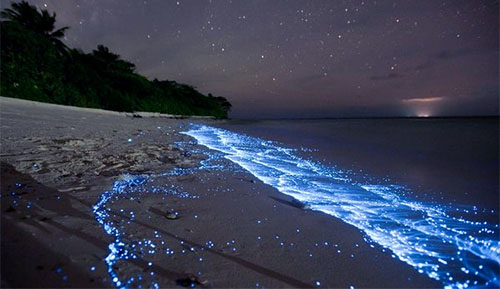
It is uncertain whether these are truly different stages in the life of a “colour” or if they are distinct, perhaps representative, samples of a biology utterly alien to human understanding.
PUPATING COLOUR
This form of the colour is most vividly described in H.P. Lovecraft’s original “Colour Out of Space”. At the dawn of the creature’s life cycle (or at least this phase of its life cycle), it seeks vast quantities of energy (drawing lightning strikes to itself, tapping into the electrical grid, or the like). Once it has been “jump-started”, it rapidly grows by feeding on the environment around it.
However, it must be understood that this is no terrestial feeding. In some incomprehensible way, the colour is consuming the memetic content of the world around itself: This initially manifests itself by way of the colour “super-charging” the physical realization of the object. For example, fruits will grow at a prodigious rate; computer systems will achieve impossible benchmarks; animals will become capable of incredible physical feats. This hyper-expression of the memetic ideal allows the colour to rapidly process the memetic totality of its surroundings, but even at this early stage the colour’s consumption of that memetic essence is apparent: The fruit will be bitter to the taste. The computer will manifest strange run-time errors. The animals will exhibit queer and unusual behavior (often blending their traits with those of other creatures in the same region).
Once this rapid phase of initial growth is complete, the pupating colour will begin to “digest” its surroundings. What is left is a grey, desiccated reality slowly turning to empty dust. (This, however, should not be mistaken for any form of normal decay: Even in the most advanced stages of destruction, the memetic integrity of the original will still remain horrifically intact. Thus, for example, bodies half-turned to dust will still exhibit slow and deliberate movement, betraying that the original consciousness is still trapped somehow within.)
At the end of its pupation, the colour undergoes a metamorphosis into a secondary (or perhaps higher) form. The exact nature of this form, however, is unclear: Ammi Pearce described a great uplifting and withdrawing of the effervescent emanations of the colour from the great swath of land it had infested or infected, culminating in a “launch” of one (or perhaps) more entities into space.
However, in the final stages of its existence before that extraplanetary launch, there is little doubt that at least some portion (or agent) of the colour had become motile and perhaps even physically manifest (producing a “splash” within a pool of water when it retreated to a well). And there are also those, Pierce among them, who claim that something still lurks within the gray and desiccated fields of the Gardner farm. At the moment of metamorphosis could one part of the creature have launched as genetic/memetic seed pods while leaving some other post-pupating creature behind? (Or was the motile agent of the colour merely the possessed form of one of Gardners’ sons? Pierce reported that, in the final phases of their infection, mother and son would converse in screams that sounded like some alien and inhuman tongue.)
INQUISITIVE COLOUR

“I might have told myself the rust had eaten away the car until it was thin as a shell, but I was past deluding myself. All at once I knew that nothing on this beach was as it seemed, for as my hand collided with the car roof, which should have been painfully solid, I felt the roof crumble — and the entire structure flopped on the sand, from which it was at once indistinguishable.” – The Voice of the Beach, Ramsey Campbell
Where the pupating colour feasts upon the memetic content of its environment for its own aggrandizement, an inquisitive colour mimics the objects (and, eventually, animals and people) around it. Of course, it is still ultimately destructive to its environment: The templates on which it builds its mimicry (seeking and striving to understand the alien worlds in which it manifests) are built by draining the memetic content of the originals.
“But of course, the more one thinks of the beach, the stronger its hold becomes.”
Of particular interest to the inquisitive colour are intelligent beings who are inquisitive about it, to which it is drawn like a lodestone. Although perhaps it would be equally true to say that it creates the inquisition to which it is drawn. In either case, it draws those near it into a kaleidoscopic hall of mirrors and sinks its memetic hooks deep. These siren-like memes often take the form of strange patterns – often in natural phenomena (like the sands of a beach or the cascade of a waterfall), but sometimes in other forms as well (like the torn leaves of a book or the ashy cascade of a forest fire). Often those afflicted by the colour will describe a painful constriction of the skull, which is merely a physical manifestation of the colour’s memetic searing of the neural channels.
Another common manifestation of the inquisitive colour is its whisper. This inexplicable memetic earworm will attempt to manifest itself wherever possible: In the sound of the sea in seashells; a corruption of the MP3 files on a computer; an instant messenger on your phone that connects to nothing. Even if one can physically escape the inquisitive colour, often its whisper will follow, subtly infiltrating their lives and inexorably drawing them back to its origin.
Over time, the ghost-like meme patterns manifested by the inquisitive colour will begin to move and shift. As the strength of the colour grows – or, perhaps, as its understanding of the memetic realities it is processing grows clearer – the vague patterns become larger and more complicated forms (although these often fade into and out of reality). At the same time, those afflicted by the colour are slowly reduced towards the same common denominator until they are little more than metaphors of their previous existence. They will begin to vanish intermittently from reality as it becomes more obvious that the colour is transforming the physical laws of our reality (or persisting despite their hostility), and each time they return they are a little less comprehensible to human sanity.
Perhaps the most disturbing aspect of the inquisitive colour is that, in its final stages, it begins to so closely mimic the world around it that it can no longer be distinguished from reality itself. Except there is left the vague and horrible sensation that the reality it is seemingly conforming to is not actually identical to the reality which was there before; you are simply no longer able to remember or understand (or perhaps comprehend) the reality which you had known before.
If that is so, then it is possible that our world as we know it is nothing more than a fresco of inquisitive colours, laid one atop each other in the soft plaster of our minds.
There are even those, hopefully driven mad by the colour, who claim that all of reality is nothing more than layers of such colours laid out like kaleidoscopic cloth. That the scope of our worldly perception is only the craqueled interstice of the memetic matrices of a many-coloured mesh.
SENESCENT COLOUR
Senescent colours manifest effects similar to pupating colours by hyper-expressing idealized memetic forms while nevertheless subtly warping them in hideous ways, but they do not expand aggressively. This has led some to suggest that senescent colours are the opposite end of the colour’s life-cycle, but this is most likely nothing more than a terrestrial assumption being applied to something far more complex and alien.
The fallibility of this comforting lie is perhaps best suggested by the rich psychological effects which are manifested by the senescent colour. These groping accords or hallucinogenic visions make it seem as if the senescent colour is trying to communicate (or perhaps inculcate) complex and alien memetics into the consciousness of those coming into contact with it. But often the transformative wake of these incoherent concepts nonetheless leaves behind a veneer of alluring ideas. These ideas, in turn, can prove seductive even to those who never come near the senescent colour. Is the senescent colour truly dormant in the decrepitude of age? Or is it merely more insidious in the viral paths of its memetic transformations?
Similarly, relics infected by a senescent colour often become the focal point for mass conversions. And the subtler (and perhaps more important) question is: Mass conversions to what?
It is said that a senescent colour danced in the halls of Solomon’s Temple, inspiring pale copies of itself in ivory pomegranates. When the Temple fell, it was carried away from that place in the Ark of the Covenant.
Another may have lit Excalibur’s blade and sought to transform the emerald isle.
When the Houmuwu ding was unearthed in Wuguan Village in 1939, the senescent colour that clung to its bronze walls may have seeped out into the Yellow River and sung a song of Cultural Revolution until its ghastly harmonies marched 30 million to their deaths.












Creepy! Makes me think of the recent articles about the cultural birth of the color blue.
http://www.scp-wiki.net/scp-8900-ex
“The natural blue of the sky has been replaced with a gross and unnatural shade, and the green of trees has been equally corrupted. SCP-8900 has brought ruin down upon the entire visible spectrum, and we have been overrun.”